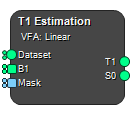T1 Estimation

Calculates a T1 map using the variable flip angle (VFA) method. The input must be a multi-channel image, where each volume has an associated flip angle (FA), however more images are advised if a larger range of T1 values are expected. Flip angle (FA) and repetition time (TR) are detected automatically and it is required that the TR is the same in all images.
In addition to the images with varying flip angle, a B1 map can also be provided to improve the accuracy, in particular at high field strengths. The B1 map represents a scaling of FA, hence value 1 indicates that the nominal FA is achieved. An optional mask can also be provided to limit the calculations to a region.
Produces a T1 map in the same units as TR, and a \(S_0\) map which is a proton and \(T2^*\)-weighted image. The parameter values are obtained by fitting the data to equation (1) directly or a linearized version of the of equation (1)[1]:
where \(n\) is the number of images used.
Inputs
Dataset
An image or a list of images (for batch processing) where channel dimensions are used for the different flip angles. At least two volumes are needed and they should have the same \(TR\) and echo time.
Type: Image, List, Required, Single
B1
B1 correction map(s). A value of \(1\) indicates that that the actaual flip angle is at the nominal value. A single 3D volume should be provided for all flip angles.
Type: Image, List, Optional, Single
Mask
Mask(s) used to confine the region in which the signal model is fitted.
Type: Mask, List, Optional, Single
Outputs
T1
The estimated \(T1\) parameter map.
Type: Image
S0
The estimated \(S_0\) parameter map.
Type: Image
Settings
Configure
Algorithm Selection
Use a linearized or a nonlinear fitting model. When selecting a nonlinear model, equation (1) is fit directly with a square loss term. In the linearized case the data is transformed to yield a system of linear equations.
Values: Linear, NonLinear
Batch Size Integer
The number of voxels that are computed per batch. This is a trade-off between performance and memory consumption.
Keep Metadata Boolean
Keep or discard metadata in the parameter maps.
Configure NonLinear
Tolerance Float
The threshold change in the objective function. Changes smaller than this value imply that the fitting has converged.
Max Iterations Integer
Maximum number of iterations.
Return Convergence Map Boolean
Output a binary mask, where all true voxels have converged in the fit. This can be used to exclude voxels that did not converge.
Metadata
Repetition Time Source Selection
Select the \(TR\)-value source for the calculation. The \(TR\)-values can be taken from the metadata, or can be supplied as an input Numeric Array.
Values: Metadata, Numeric Array Input
Flip Angle Source Selection
Select the FA source for the calculation. The FA values can be taken from the metadata, or can be supplied as an input Numeric Array.
Values: Metadata, Numeric Array Input
Repetition Time Tag Text
The \(TR\)-value tag name in the metadata.
Flip Angle Tag Text
The FA tag name in the metadata.
References
[1] H. L. M. Cheng and G. A. Wright, “Rapid high-resolution T1 mapping by variable flip angles: Accurate and precise measurements in the presence of radiofrequency field inhomogeneity,” Magn. Reson. Med., vol. 55, no. 3, pp. 566–574, 2006.
See also
Keywords:
Copyright © 2025, Hero Imaging AB
